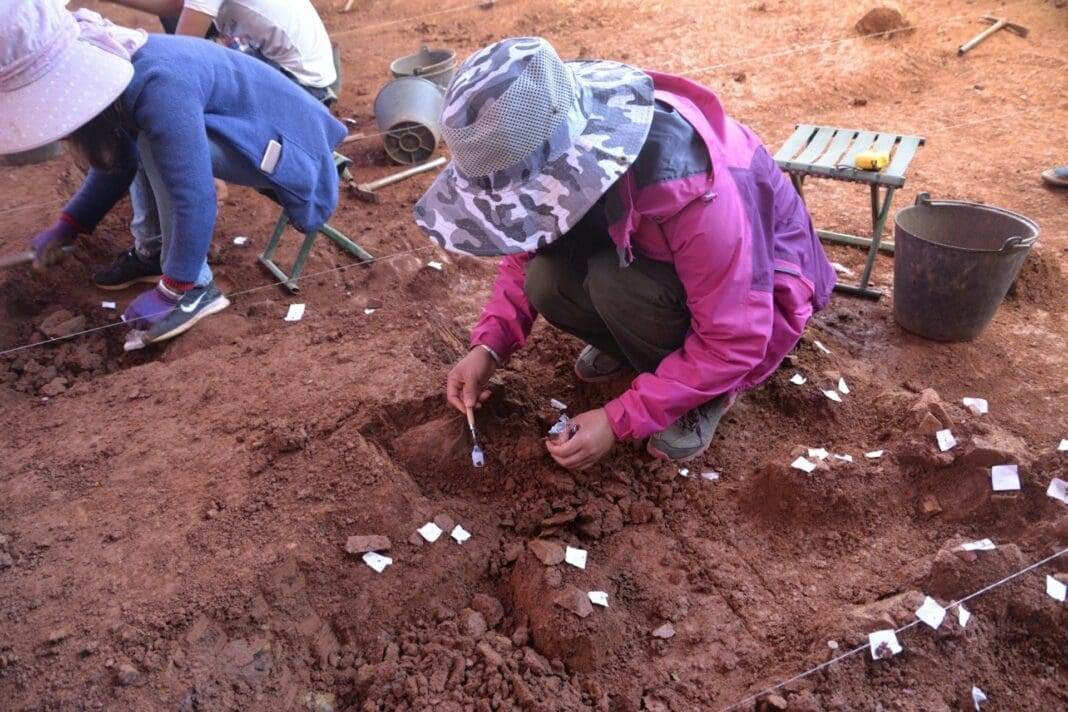New technologies today often involve electronic devices that are smaller and smarter than before. During the Middle Paleolithic, when Neanderthals were modern humans’ neighbors, new technologies meant something quite different: new kinds of stone tools that were smaller but could be used for many tasks and lasted for a long time.
Archaeologists like me are interested in the Middle Paleolithic – a period spanning 250,000 to 30,000 years ago – because it includes the first appearance of our species, our arrival into many parts of the world for the first time, and our invention of many new kinds of stone tools.
In our study just published in the Proceedings of the National Academy of Sciences, a team of international collaborators and I describe our discovery in China of the first complete example of a Middle Paleolithic technology previously seen only in Europe and the Middle East.
Archaeologists have thought that ancient people in East Asia completely skipped the Middle Paleolithic. Our discovery challenges the long-standing notion that while ancient people in Europe and Africa were inventing new tools during this period, people of East Asia stuck to only the most basic tools that remained unchanged for thousands of years.
The tool we’ve identified is called a Quina scraper. This type of stone tool is well known from archaeological sites in Europe and the Middle East.
Quina scrapers are typically quite thick and asymmetrical, with a broad and sharp working edge that shows clear signs of being used and resharpened multiple times. This shape results in durable cutting edges, ideal for long cycles of use followed by resharpening.
People used Quina scrapers to scrape and cut soft materials, such as meat and animal skins, and medium-hard materials, such as wood. We know this from tiny scratches and chips on the scrapers that match traces caused by working these materials in experiments using contemporary stone tools.
European archaeologists believe that Quina scrapers were invented to meet the needs of highly mobile hunters living in cool and dry climates. These hunters were focused on seasonal migratory prey such as reindeer, giant deer, horse and bison. Quina scrapers would have helped them process their kills into food and other resources – for example, to extract marrow.
Our team, led by Hao Li of the Institute of Tibetan Plateau Research and Qijun Ruan of the Yunnan Provincial Institute of Cultural Relics and Archaeology, excavated Quina scrapers and related stone tools from the Longtan archaeological site in southwest China.
Our colleague Bo Li at the University of Wollongong used optical luminescence dating methods on the layers of earth that contained the artifacts. This technique can identify how much time has passed since each individual sand grain was last exposed to the Sun. Dating many individual grains in a sample is important because tree roots, insects or other animals can mix younger sediments down into older ones.
After we identified and removed intrusive younger grains, we found the layers containing the artifacts were 50,000 to 60,000 years old. This is roughly the same time Quina scrapers were being used in Europe at Neanderthal sites.
Keliang Zhao from China’s Institute of Vertebrate Paleontology and Paleoanthropology looked at pollen grains from the Longtan excavations. He found that the Middle Paleolithic people of Longtan lived in a relatively open forest-grassland environment and a dry and cool climate. This environment is similar to that of Quina sites in Europe.
Davide Delpiano, Marco Peresani and Marie-Hélène Moncel, experts on European Middle Paleolithic tools, joined our team to help with the comparison of the Chinese and European specimens and confirm their similarities.
Hélène Monod, from Universidad Rovira i Virgili in Spain, looked at our Quina scrapers under the microscope and found traces on them from scraping and scratching bones, antlers and wood. She also found polish from using the tools on meat, hides and soft plants.
Our new discovery of Quina scrapers joins another recent find of a different kind of Middle Paleolithic technology in East Asia: Levallois tools from Guanyindong Cave in Guizhou Province in south-central China. Levallois tools result from a distinctive multistep sequence that efficiently produces lots of useful cutting tools, with minimal wasted stone. Taken together, these two finds make a strong case that Middle Paleolithic technologies were present in East Asia.
But why are we only just finding this Quina tool kit now, when it has been known in Europe for such a long time?
One reason is that archaeologists have been looking in Europe for longer than almost anywhere else in the world. Another reason Middle Paleolithic evidence appears rare in East Asia is because what now seem to be less typical variations of the Quina tool kit previously found in China had been overlooked, likely due to archaeologists’ narrow definitions based on European examples.
The Quina tools at Longtan are among the earliest artifacts from that site, which makes it hard for researchers to determine the origins of this new technology. Was it introduced by visitors from Europe? Or did local people in East Asia independently invent it?
To answer these questions, we hope to find more Quina scrapers at sites with deeper – meaning older – layers than Longtan. If older layers hold what look like the remnants of experiments in stone toolmaking that would eventually result in Quina tools, it suggests Quina tools were invented locally. If deeper layers have dissimilar tools, that suggests Quina technology was introduced from a neighboring group.
We also hope future work will reveal who made these tools. Our excavations at Longtan did not find any human bone or DNA that could help us identify the toolmakers.
During the Middle Paleolithic, there were multiple human species that could make tools like this. It could have been modern humans like us. But it could also have been Neanderthals. Considering that the Quina technology in Europe is directly associated with Neanderthals, this seems likely. But it could also have been Denisovans, an extinct species similar to modern humans found during this time in Siberia, the Tibetan Plateau and Laos, or even a new human species that hasn’t been seen before.
Whoever was making and using these Quina scrapers, they were able to be inventive and flexible with their technology, adapting to their changing environment.
This article is republished from The Conversation, a nonprofit, independent news organization bringing you facts and trustworthy analysis to help you make sense of our complex world. It was written by: Ben Marwick, University of Washington
Read more: Ancient DNA is revealing the genetic landscape of people who first settled East Asia New dates for ancient stone tools in China point to local invention of complex technology Melting Mongolian ice reveals fragile artifacts that provide clues about how past people lived
Ben Marwick does not work for, consult, own shares in or receive funding from any company or organization that would benefit from this article, and has disclosed no relevant affiliations beyond their academic appointment.














